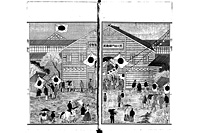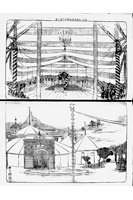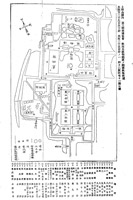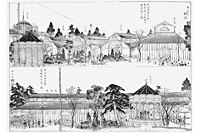Third National Industrial Exhibition
Publicity to the world
- Period
- : April 1, 1890 - July 31, 1890
- Venue
- : Tokyo Ueno Park
- No. of visitors
- : 1,023,693
Initially, under the leadership of Tsunetami Sano, Vice President of the Japanese Commission to the Vienna Exposition, this event was planned as an "Asian Exposition," a preparatory step for holding an international exposition in Japan in the future. It was thought that an event bigger than the past ones, even if only slightly bigger, should be held in 1890, the 2,550th year of the Japanese Imperial reign. Due to the opposition by Masayoshi Matsukata, the Minister of the Okura-sho, and others, the event was eventually held as the third National Industrial Exhibition, a domestic event. With this as a background, even though it was a domestic event, it emphasized the attraction of foreign visitors as a means of expanding sales channels for the exhibits, with many invitations sent all over the world. As a result, the event drew 246 visitors from abroad.
The third National Industrial Exhibition failed to increase its visitors drastically, partly due to the recession, the spread of influenza, a long spell of rainy weather, and the election of the House of Representatives of the Imperial Diet on July 1. Moreover, as it had done since the first National Industrial Exhibition, the government removed the aspect of entertainment from the event, even though the general public was no longer interested in the exhibits simply because they were from Western countries. This is believed to be one of the factors contributing to the government's failure to attract many visitors.
With a floor area of 9,725 tsubo (32,000 m2), the venue comprised not only the Main Building, but also the Fine Art Building, the Agricultural and Forestry Building, the Animal Building, the Marine Production Building, the Machinery Building, and the Foreign Samples Building with foreign products in it. The total area of the structures increased approximately 1.3-fold from that of the second exposition, with the number of exhibits rising to 441,458. Of particular note regarding this event was the Tokyo Electric Lamp Company operating a streetcar at the venue as Japan's first electric railcar.
The exhibits displayed by government agencies were regarded as ineligible for prize rewards, highlighting the government's intention to promote industries in the private sector. Since such rewards and other judgment results were considerably influential to the sales of the exhibits, some exhibitors filed lawsuits, demonstrating their dissatisfaction with the grades of the awards given to them. Also, this exposition is noteworthy in that it promoted the design registration system which had been introduced into Japan in 1888. To spread the recognition of the Isho-jorei (design act) in Japanese society, the government did not impose an application fee or a registration fee on the exhibits of the exposition, thereby rapidly increasing the number of design registration applications.
Despite such new initiatives and the increase of the number of the exhibits, the third National Industrial Exhibition, held against the backdrop of the recession and other unfavorable factors, ended with a significant inventory of unsold exhibits.
- References:
Kuni, Takeyuki.: Hakurankai no jidai: Meiji seihu no hakurankai seisaku (Iwata shoin, 2005) <D7-H68>
Yoshida, Mitsukuni (ed).: Zusetsu bankoku hakurankaishi: 1851-1942 (Shibunkaku shuppan, 1985) <D7-66>





